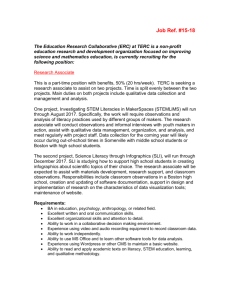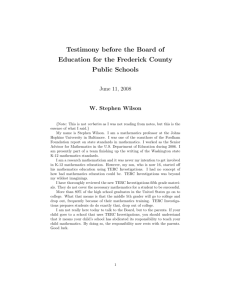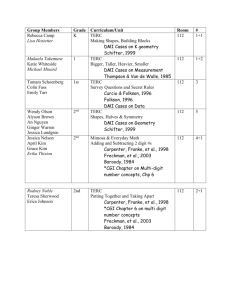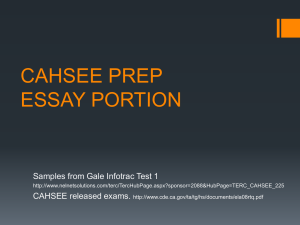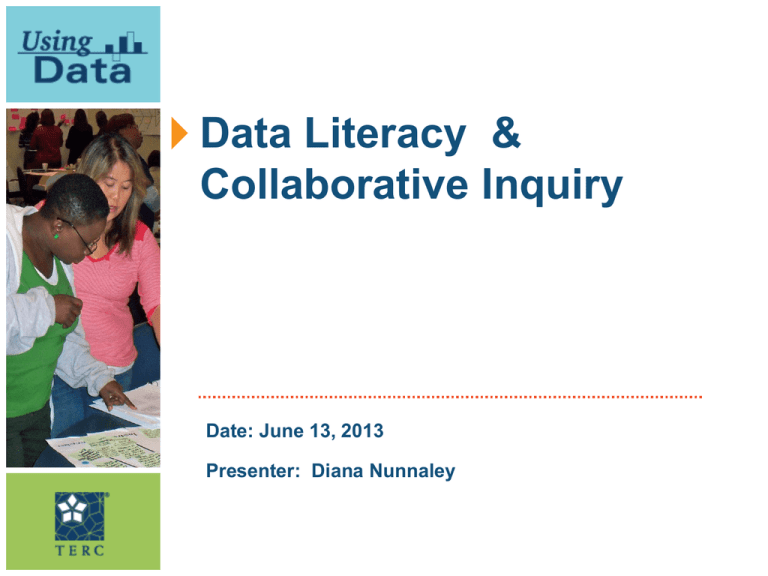
Data Literacy &
Collaborative Inquiry
Date: June 13, 2013
Presenter: Diana Nunnaley
Leaders need preparation to use data
Most people who currently work in public schools
weren’t hired to do this work, nor have they been
adequately prepared to do it either by their
professional education or by their prior experience in
schools.
—Elmore, 2002, p. 5
Using Data ©TERC 2013
Let’s Agree On What We Mean
Data Driven Culture?
What should the result be?
What is effective data use?
Turn to someone near you and discuss
the above questions.
Using Data ©TERC 2013
Key Characteristics – High Performing
Schools
Thoughtful public discussion of
important and central issues
Collaboration –co-constructing the new,
not just cooperation
Shared norms and values
Focus on student learning
Using Data ©TERC 2013
Karen Seashore Louis, 2008
http://workingconditions.net/?ca
t=8
NSDC St. Louis, 2009
Synthesis – Research on Data Use
• Establish a clear vision for school wide data use.
• Develop and maintain a district wide data system.
• Make data part of an ongoing cycle of instructional
improvement.
• Provide supports that foster a data-driven culture within
the school.
• Teach students to examine their own data and set
learning goals.
Using Data ©TERC 2013
The Data Divide
Data
Results
Professional Development Needed
Data
Leadership
& Capacity
Structured
Collaboration
Frequent
Data Use
Results
Instructional
Improvement
Grade 4 Data Team
Using Data ©TERC 2013
The Data Team
Data teams are school- or
district-based teams
comprising administrators,
teacher-leaders, and data
and other specialists who
engage in ongoing dialogue
informed by data and use
the process of collaborative
inquiry to improve teaching
and learning.
Using Data ©TERC 2013
Data Coach
Data coaches are school
and/or district leaders or
service providers who
work directly with a Data
Team to lead them
through the process of
data analysis using
collaborative inquiry.
Using Data ©TERC 2013
An Underlying Assumption
Data have no meaning. Meaning is imposed
through interpretation. Frames of reference,
the way we see the world, influence the
meaning we derive from data. Effective data
users become aware of and critically
examine their frames of reference and
assumptions. Conversely, data can be a
catalyst to rethinking our assumptions.
Based on Bruce Wellman and Laura Lipton, Data-Driven Dialogue, 2004
Data-Driven Dialogue
Phase 1
Phase 2
Phase 3
Phase 4
Predict
Go Visual
Observe
Infer/Question
Surfacing experiences,
possibilities, expectations
What are some
predictions that we
might make?
• What assumptions
might be underlying our
predictions?
• What are some
questions we are
asking that this data
might help us answer?
•
•
What might we be able
to learn from this data?
Communicating ideas
about data using visual
images and representations
•
What data do we want
to convey?
• What visual would
communicate this data
most clearly, accurately
and completely?
• What information and
labels will we need to
provide to the visual to
ensure that the data
represented is clear?
Analyzing and making
observations about data
• What important points
seem to “pop out”?
• What are some
patterns or trends that
are emerging?
• What seems to be
surprising or
unexpected?
• What are some things
we have not explored?
Generating possible
explanations for the
observations of the data
• What inferences and
explanations can we
draw?
• What questions are we
asking?
• What additional data
might we explore to
verify our
explanations?
• What tentative
conclusions might we
draw
Adapted from Wellman, B., & Lipton, L., 2004. Data-Driven Dialogue: A Facilitator’s Guide to
Collaborative Inquiry. Sherman, CT: MiraVia LLC. Used with permission.
The Using Data Initiative, TERC© 2007. All rights reserved.
DCK Chart & Handout
Multiple Measures Sharpen Our
Using Data ©TERC 2013
Data Drill Down
Triangulate
Student Learning Data
Task 5: Build Data Literacy
Source 2: Benchmark Assessments
Task 6: Aggregate Data
Task 7: Disaggregated Data
Task 8: Content Strand
Task 9: Item Data
Task 10: Student Work
Task 11: Common Assessments & other
Task 12: Develop a Student-Learning
Problem and Goal
Using Data ©TERC 2013
What’s My Line? - Do the Work!
The line segment below has been divided into three
equal parts and labeled with letters as shown. The
value of point A is 0, point B is 3/4, and the value of
point D is 2.25
A
B
0
3/4
C
D
2.25
1a. What is the value of point C?
1b. Plot the value of point C on the number line.
Show all of your work.
Explain how you found the point value of C.
Source:STAR Program,Center for Educational Services, Auburn,Maine (permission pending)
Using Data ©TERC 2013
18
Using Data ©TERC 2013
PM p. 121
PM, pp. 125 & 126
Student Work: Deconstruct Task
19
Task Deconstruction Example
Using Data ©TERC 2013
20
Sample Student Learning Problem Statement
Seventh-grade students at Lincoln School are below
grade level in mathematics. Weak areas are number sense and algebraic
reasoning as evidenced by these data:
• 64% of students are below proficiency on the 2013 Nebraska State
Assessment
• 52% of students are below basic on the 2013 district benchmark
assessment
• 37% of students scored a 1 on the 2013 school common assessment
These performance gaps were noted:
•
49% of Special Needs students are below proficiency, while 33% of all
other students are below proficiency as evidenced by the 2013
Nebraska State Assessment
Using Data ©TERC 2013
“Too often in
education, we start
with answers before
we have understood
the problem we’re
trying to solve.”
Tony Wagner, Co-Director of Change Leadership
Group, Harvard University Graduate School.
Education Week, August 15, 2007.
Fishbone Cause-and-Effect Analysis
Also known as the Ishikawa Diagram
Fishbone w/Spend a Buck
Equity
All students not
taught at grade
level.
Critical Supports
School culture
not collaborative
Teachers have
low expectations
for some students
6th-grade unit on motion not
aligned with new standards.
K-5 curriculum not
developing motion
concepts
Curriculum
Teacher
Preparation
Teachers not
comfortable
with physical
science content
Fragmented PD
Inconsistent
implementation of
curriculum units
Instruction
Unit assessments
not aligned with
national assessments
Assessment
Problem
6th-grade
students are
below
proficiency in
physical
science;
achievement
gap between
Special
Education
students and all
other students
Verify Causes: Research Wall
Priority
Causes
Questions
Sources
Findings
Cause 1
Cause 2
Cause 3
Using Data ©TERC 2013
25
Logic Model Chain
Student
Learning
Problem
& Cause
IF WE DO…
Strategy
Strategy
Strategy
A
Student
Learning
Goal
B
Outcome
Outcome
THEN…
Using Data ©TERC 2013
Outcome
Monitoring
1
To what degree are we
implementing our
strategy?
2
Is the strategy being
implemented achieving the
desired outcome?
How will we know?
How will we know?
What evidence will need
to collect and
summarize?
What evidence will need
to collect and analyze?
Using Data ©TERC 2013
Classsroom Focused: Action Plan
Classroom Focused Action Plan
School: Memorial Elementary
Content Area: Mathematics
Data Team: Grade 4
Contact Person: Patti Wright
Student Learning Problem: Students are not performing well when computing fractions, decimals and percentages.
Targeted Cause(s)/Hypothesis: If we provide more opportunities for students for problem solving, particularly at level 2 DOK, they will
have the knowledge and skills they need to improve results.
Strategy to be Implemented
What will you do?
We will increase the use of
academic language at DOK level 2
in classroom questioning.
(See attached.)
Beginning
When?
Immediately
We will develop or identify and use
at least 6 tasks requiring students
to explain the connection between
their visualization and the
procedures to solve the problem or
represent how to solve the problem
if they don’t yet have the procedure.
Tasks identified
and refined –
within one week
©TERC 2013
Using
DataRoom
Next meeting:
201, Sept. 19.
Use of tasks – in
one week
Completed by?
Resources needed?
Oct. 1
Additional information re:
structuring more rigorous
lessons
Sept 19
Open-ended tasks at
DOK 2 (Patti Wright will
share with group via
email.)
Data collected to monitor
implementation? Results?
· Peer observations
· Teacher reflection
· Lesson plans
· Data Team meeting notes
· Assessment items
· Student results on assessment
items
· Progress monitoring results
· Interim benchmarks results in
November
Data Analysis Leads to School Improvement
Plans
• Grade and course teams report findings
to whole faculty.
• Faculty analyzes the results for trends
and patterns.
• Results of the faculty analysis inform the
development of the School Improvement
Plan.
Using Data ©TERC 2013
شكرا
شكراً جزيالً
شكراً جزيالً
شكراش
كشكرا
شكرا
را
Using Data ©TERC 2013

